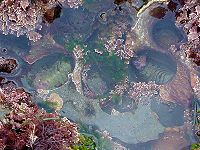Tide pool
From Wikipedia, the free encyclopedia
Tide pools (also tidal pools or rock pools) are rocky pools by the ocean that are filled with seawater. Tide pools can either be small and shallow or large and deep. The small ones are usually found far back on the shore and the large ones are found nearer to the ocean. Tide pools are formed as a high tide comes in over a rocky shore. Water fills depressions in the ground, which turn into isolated pools as the tide retreats. This process, repeated twice a day, replenishes the seawater in what otherwise might be a stagnant pool.
The area that is covered by high tide and exposed by low tide is called the intertidal zone, or foreshore. This area is often further divided into different zones based on the life forms that live there.
Life in tide pools
Organisms that have made tidepools their home must be well adapted to adjust to the drastic changes in environment that come with the changing of tides each day. Organisms living in this environment must have adaptions for both wet and dry conditions. Hazards include being smashed or carried away by rough waves. Typical inhabitants include sea anemones, barnacles, chitons, crabs, isopods, limpets, mussels, sea stars, snails and whelks.
The tides bring fresh oxygen and food to the pools twice a day. Between tides, some of the smaller pools become warm and begin to dry up. In order to survive, the animals hide under rocks and seaweed. Sessile creatures such as the barnacles and sea anemones can seal themselves off or retract their appendages, the better to conserve water while exposed to air. Some deeper pools will not dry out completely between tides, and can even harbor small fish.
It should be noted that disturbing the animals in a tide pool can be hazardous to them. Even moving seaweed can expose small creatures underneath that can die in the direct sun, and prying loose any creatures held fast to the rocks is almost always fatal to the animal.


No comments:
Post a Comment